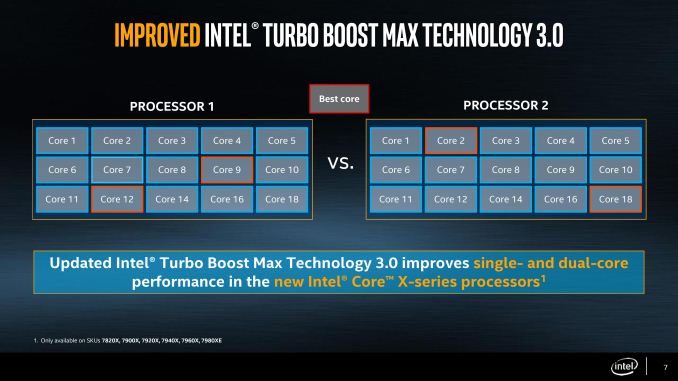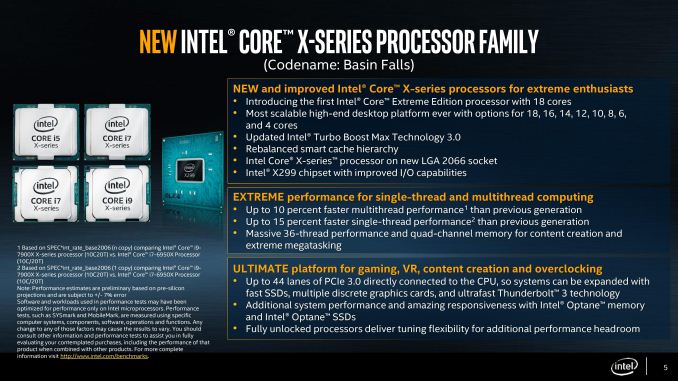Intel Announces Skylake-X: Bringing 18-Core HCC Silicon to Consumers for $1999
by Ian Cutress on May 30, 2017 3:03 AM ESTAnnouncement Four: AVX-512 & Favored Core
To complete the set, there are a couple of other points worth discussing. First up is that AVX-512 support coming to Skylake-X. Intel has implemented AVX-512 (or at least a variant of it) in the last generation of Xeon Phi processors, Knights Landing, but this will be the first implementation in a consumer/enterprise core.
Intel hasn’t given many details on AVX-512 yet, regarding whether there is one or two units per CPU, or if it is more granular and is per core. We expect it to be enabled on day one, although I have a suspicion there may be a BIOS flag that needs enabling in order to use it.
As with AVX and AVX2, the goal here is so provide a powerful set of hardware to solve vector calculations. The silicon that does this is dense, so sustained calculations run hot: we’ve seen processors that support AVX and AVX2 offer decreased operating frequencies when these instructions come along, and AVX-512 will be no different. Intel has not clarified at what frequency the AVX-512 instructions will run at, although if each core can support AVX-512 we suspect that the reduced frequency will only effect that core.
With the support of AVX-512, Intel is calling the Core i9-7980X ‘the first TeraFLOP CPU’. I’ve asked details as to how this figure is calculated (software, or theoretical), but it does make a milestone in processor design. We are muddying the waters a bit here though: an AVX unit does vector calculations, as does a GPU. We’re talking about parallel compute processes completed by dedicated hardware – the line between general purpose CPU and anything else is getting blurred.
Favored Core
For Broadwell-E, the last generation of Intel’s HEDT platform, we were introduced to the term ‘Favored Core’, which was given the title of Turbo Boost Max 3.0. The idea here is that each piece of silicon that comes off of the production line is different (which is then binned to match to a SKU), but within a piece of silicon the cores themselves will have different frequency and voltage characteristics. The one core that is determined to be the best is called the ‘Favored Core’, and when Intel’s Windows 10 driver and software were in place, single threaded workloads were moved to this favored core to run faster.
In theory, it was good – a step above the generic Turbo Boost 2.0 and offered an extra 100-200 MHz for single threaded applications. In practice, it was flawed: motherboard manufacturers didn’t support it, or they had it disabled in the BIOS by default. Users had to install the drivers and software as well – without the combination of all of these at work, the favored core feature didn’t work at all.
Intel is changing the feature for Skylake-X, with an upgrade and for ease-of-use. The driver and software are now part of Windows updates, so users will get them automatically (if you don’t want it, you have to disable it manually). With Skylake-X, instead of one core being the favored core, there are two cores in this family. As a result, two apps can be run at the higher frequency, or one app that needs two cores can participate.
Availability
Last but not least, let's talk about availability. Intel will likely announce availability during the keynote at Computex, which is going on at the same time as this news post goes live. The launch date should be sooner rather than later for the LCC parts, although the HCC parts are unknown. But no matter what, I think it's safe to say that by the end of this summer, we should expect a showdown over the best HEDT processor around.


















203 Comments
View All Comments
ddriver - Tuesday, May 30, 2017 - link
They can do anything between 8 and 16 in the threadripper design, if the market should call for it.ddriver - Tuesday, May 30, 2017 - link
They have 4 6 and 8 core zen dies, but they gotta have some with 5 or 7 working cores. Those could be sold as 4 and 6 cores with one disable core, or they can be slapped on the same chip for 10 and 14 core products, no working cores wasted.ilt24 - Thursday, June 1, 2017 - link
ddriver..."They have 4 6 and 8 core zen dies"Actually AMD only have one 8 core Zen die. All of this years Ryzen 7/5/3 chips are made from that die they just disable cores to get the lower core counts. Threadripper is made from a pair of these die in an MCM package, with some cores disabled for some SKUs. The EPYC processor will be made from 4 of these die in a single package. If AMD for some reason wanted to match Intel's 18 cores they would need to make a three die MCM chip with 6 die disabled.
ddriver - Friday, June 2, 2017 - link
"Cores" as in "active/working cores".I doubt they'll be making 3 die MCM solutions, that is too asymmetric. Also, they will be throwing I/O away, as the HEDT socket doesn't have the pins to facilitate it.
It is unlikely that AMD will have a 18 core SKU in either HEDT or server. Threadripper will stop at 16. Epyc will start at 20, if the market calls for it. That's 4 modules with 5 active cores each. I doubt Amd will produce asymmetric designs. So that's 20, 24, 28 and 32 cores for Epyc. And half of that for threadripper - 10, 12, 14 and 16 cores.
Lacking an 18 core solution is not a big whoop, and most certainly not worth the R&D money.
ilt24 - Friday, June 2, 2017 - link
"I doubt they'll be making 3 die MCM solutions,"I agree, which was why I said "If AMD for some reason wanted..."
"Epyc will start at 20"
I think AMD will also have lower core count EPYC chips, as a good part of the market uses them. ...and a 16 core version made from a pair of die will cost them quite a bit less then a 20 core+ version made from 4 die.
XabanakFanatik - Tuesday, May 30, 2017 - link
The reason the price jumps from 8 to 10 cores like that is you are paying from the 28 lane skus into the 44 lane skus along with the extra cores. Once there, you are only paying for the increased core count.theuglyman0war - Thursday, June 8, 2017 - link
that's a tuff sell... the 8 core's higher base clock and 44 lanes at $599 would had been the easy purchase. Now if threadripper 16c actually releases at the rumor $849 I can't see any silver lining for Intel except for 18 core bragging rights. the 10 core benchmarks would have to have some kind of threadripper 16 core beating magic to justify the $1000 price. All the 8 core skylake has to is embarrass the 1800x in benchmarks ( and it could had also done so if it just made that 8 core solution an i9 with 44 lanes )Not quite enough to be more awesome?
The new larger L2 caching seems like a big wrench in the works where direct comparison might easily fall apart if AMD does not have equal advanced on threadripper that trumps infinity fabric woe?
At the end of the day time for benchmarks and support for AVX 512 etc... will take some time? I ain't close to pulling a trigger till I C. ( tho I B really excited to C! )
jjj - Tuesday, May 30, 2017 - link
Intel reacts to Ryzen and they leave room for AMD to do up to 2x better lol.alamilla - Tuesday, May 30, 2017 - link
Those prices are HILARIOUS.C'mon Intel
jjj - Tuesday, May 30, 2017 - link
I expect the cheapest 16 cores Threadripper to allow users to fit the CPU plus mobo in 1k$ so 799$ for the CPU.Intel's play in recent years has been to push ASPs up and offset declining units but AMD has to find the balance between margins and share gains- Intel has no share left to gain. AMD doesn't have yield issues with MCM so they could easily go even lower than 799$ for 16 cores.
What i am curious about is if AMD has any SKUs with less than 12 cores and how aggressive they get with those.
And ofc let's see if AMD has a new revision for Ryzen.
Doubt they launch Threadripper today, before Naples.